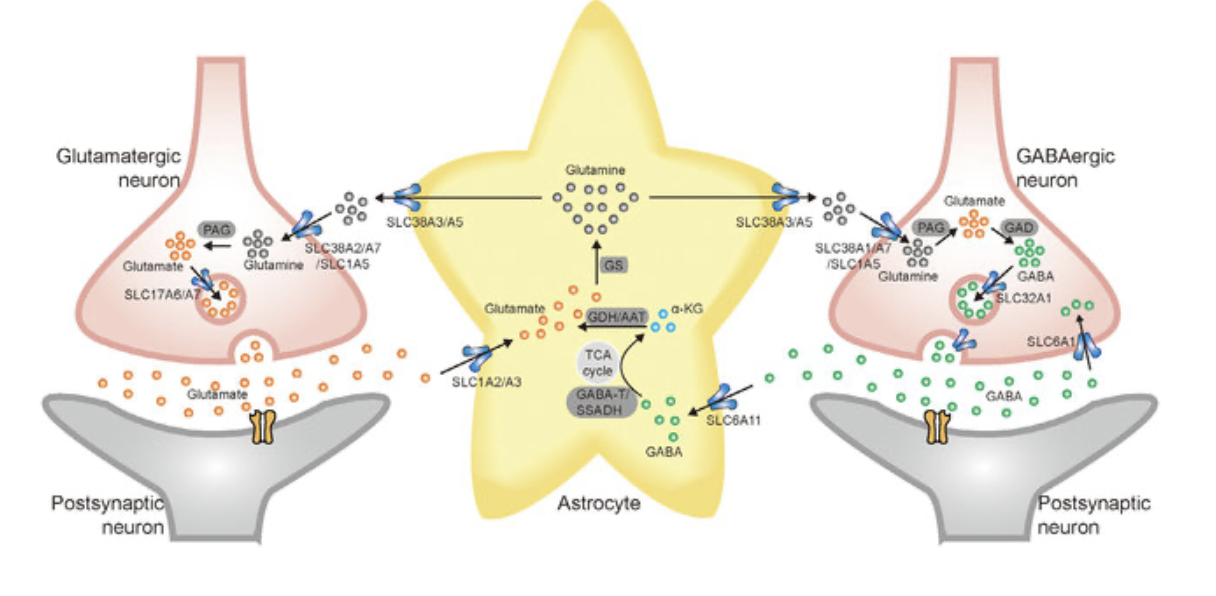Neurotransmitters (Amino Acid)
Glutamatergic neurons are a type of neuron that primarily release glutamate, the main excitatory neurotransmitter in the brain. GABAergic neurons are a type of inhibitory neuron in the central nervous system (CNS) that primarily use gamma-aminobutyric acid (GABA) as their neurotransmitter.
GABA is synthesized from glutamate by the enzyme glutamic acid decarboxylase (GAD), which is the rate-limiting step in this pathway. Neurons can transition from an excitatory to an inhibitory role by adjusting their neurotransmitter synthesis. When glutamate levels increase, some neurons enhance GAD expression, resulting in greater GABA production. This adaptation enables neurons to respond to changing physiological conditions, providing necessary inhibitory signals to balance excitatory activity and maintain homeostasis within neural circuits.
The main solute carrier transporters involved in glutamate/GABA-glutamine cycle (Image taken from: Hu C, …, Chen L. Asian J Pharm Sci. 2020).

| Neurotransmitter | Releasing Neurons | Receptors | Specific Parts of CNS |
|---|---|---|---|
| Glutamate | Glutamatergic neurons | Ionotropic (AMPA, NMDA, Kainate) and Metabotropic (mGluRs) | Cortex, hippocampus, cerebellum |
| GABA | GABAergic neurons | Ionotropic (GABAA) and Metabotropic (GABAB) | Widespread, especially in cortex and cerebellum |
| Glycine | Glycinergic neurons | Ionotropic (Glycine receptors) | Spinal cord, brain stem |
AMPA: α-amino-3-hydroxy-5-methyl-4-isoxazolepropionic acid; NMDA: N-methyl-D-aspartate; mGluRs: Metabotropic Glutamate Receptors
Ionotropic receptors are fast-acting receptors that form ion channels; when activated by a neurotransmitter, they allow ions to flow directly across the membrane, leading to rapid changes in neuronal excitability.
Metabotropic receptors, on the other hand, are slower and act through signaling cascades involving second messengers, modulating cellular functions over a longer duration. This distinction is crucial for understanding how neurotransmitters influence neuronal communication and overall brain function.
| Receptor Type | Type | Composition | Functions |
|---|---|---|---|
| NMDA Receptors | Glutamatergic | - Obligatory heteromers drawn from GluN1, GluN2A-D, GluN3A-B subunits - GluN1 has 8 isoforms (alternative splicing) - Di-heteromeric (GluN1 + GluN2) or tri-heteromeric (GluN1 + multiple GluN2/3) | - Requires both glutamate and glycine for activation - Permeable to Ca²⁺, Na⁺, and K⁺ - Blocked by Mg²⁺ at resting potential - Key in synaptic plasticity, memory, and learning |
| AMPA Receptors | Glutamatergic | - Homomers or heteromers from GluA1, GluA2, GluA3, GluA4 - Regulated by TARPs (γ2, γ3, γ4, γ8) | - Mediates fast excitatory synaptic transmission - Na⁺ and K⁺ permeable; Ca²⁺ permeability depends on GluA2 subunit editing - Involved in long-term potentiation (LTP) and synaptic plasticity |
| Kainate Receptors | Glutamatergic | - Homomers or heteromers from GluK1, GluK2, GluK3 - GluK4, GluK5 form high-affinity binding sites but are non-functional alone - Regulated by Neto proteins | - Modulates excitatory synaptic transmission - Requires extracellular Na⁺ and Cl⁻ for activation - Has both ionotropic and metabotropic functions - Permeable to Na⁺, K⁺, and sometimes Ca²⁺ |
| GABAA | GABAergic | Pentameric complex: α (1-6), β (1-3), γ (1-3), δ, ε, θ, π, ρ subunits | Ionotropic; mediates fast synaptic inhibition by increasing Cl⁻ conductance |
| GABAB | GABAergic | Heterodimer: GABAB1 and GABAB2 subunits | Metabotropic; inhibits adenylyl cyclase, decreases Ca²⁺ and K⁺ conductance |
| GABAC | GABAergic | Homomeric or heteromeric assemblies of ρ subunits | Ionotropic; Cl⁻ channel with slower kinetics than GABAA |
TARPs: Transmembrane AMPAR regulatory proteins
For more detailed information, you can visit the original source here and here.
